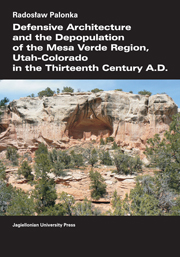Book contents
- Frontmatter
- Dedication
- Contents
- List of Figures
- Acknowledgments
- CHAPTER I Introduction
- CHAPTER II Mesa Verde region – definition, natural environment, history and methodology of research
- CHAPTER III Defining and interpreting defensive architecture
- CHAPTER IV Ethnography, ethnohistory, and Native American oral traditions concerning defensive architecture and conflicts in the Southwest
- CHAPTER V Analysis of the central Mesa Verde region architecture in the thirteenth century A.D.
- CHAPTER VI Summary and conclusions
- REFERENCES
- PHOTOGRAPHS
CHAPTER III - Defining and interpreting defensive architecture
Published online by Cambridge University Press: 05 September 2014
- Frontmatter
- Dedication
- Contents
- List of Figures
- Acknowledgments
- CHAPTER I Introduction
- CHAPTER II Mesa Verde region – definition, natural environment, history and methodology of research
- CHAPTER III Defining and interpreting defensive architecture
- CHAPTER IV Ethnography, ethnohistory, and Native American oral traditions concerning defensive architecture and conflicts in the Southwest
- CHAPTER V Analysis of the central Mesa Verde region architecture in the thirteenth century A.D.
- CHAPTER VI Summary and conclusions
- REFERENCES
- PHOTOGRAPHS
Summary
THEORY AND DIFFERENT VIEWS ON DEFENSIVE ARCHITECTURE IN NON-STATE SOCIETIES
Defensive architecture and defensive sites are commonly imagined as the medieval strongholds, castles, and fortifications built across Europe between the fifth or sixth century A.D. and the nineteenth century. The early medieval and later European fortifications exhibited traits characteristic of the architecture of both state and non-state societies; these traits were effective, especially until artillery was incorporated into warfare, but different types of fortifications continued to be used even later (Hacker 1994; Keeley et al. 2007). However, an enormous number of defensible site locations and defensive structures were utilized for defense and protection during different periods in non-state societies worldwide including some on the North American continent.
The simple definition of a “stronghold” or a defensive site is a site that is artificially defended by different kinds of fortifications or structures that protected its entrance (Hensel 1948: 16). However, it is worth mentioning that the presence of a structure that surrounds a site does not always indicate that the site or architectural feature was built for defense (Dulinicz 2000: 85). Also, although the terms “fortification” and “defensive site” are largely self-explanatory, interpreting the functions of particular ancient structures within archaeological sites, communities, or systems of related sites, is often difficult using only architectural remains and artifacts collected during archaeological investigations. The task is much easier with written records concerning specific sites or cultures.
- Type
- Chapter
- Information
- Defensive Architecture and the Depopulation of the Mesa Verde Region, Utah-Colorado in the Thirteenth Century AD , pp. 38 - 56Publisher: Jagiellonian University PressPrint publication year: 2011



